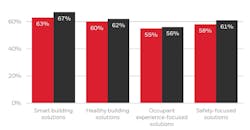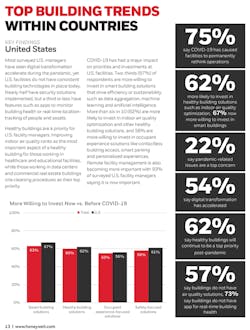Honeywell Survey: Building's Effect on Health Tops List of Back-to-Work Priorities
ATLANTA, Ga.— According to a report released on June 23 by Honeywell, 75 percent of surveyed U.S. facility managers say COVID-19 has caused them to permanently rethink how their facility operates. Nearly 6 in 10 respondents are more likely to invest in indoor air quality optimization and other healthy building solutions, while 7 in 10 are now more willing to invest in smart building solutions that help drive efficiency and support sustainability efforts.
The report, “Rethinking Buildings Post-COVID-19,” the first in Honeywell’s 2021 Building Trends series, introduces the challenges, priorities and assessments of surveyed facility managers in the United States, Germany, China and Saudi Arabia across the education, healthcare, data center and commercial real estate industries. It focuses on COVID-19’s impact on building trends and facility managers’ priorities — now and in the future.
“A notable transformation driven by the COVID-19 pandemic is prompting U.S. facility leaders to reconsider their operational strategies and invest in smarter, healthier technologies,” said Vimal Kapur, president and chief executive officer, Honeywell Building Technologies. “As occupants become more aware of how the buildings they use for work, school and care can affect their well-being, we expect them to push building owners and operators to implement new procedures with efficient, sustainable solutions that better support occupants’ safety, comfort and enhance their experiences, not only for the immediate return to office but for the long term as well.”
The survey results from facility managers in the U.S. underscore five key themes:
1. Sources say the survey suggests the pandemic will likely have a lasting impact on facility management and operations. Seventy-five percent of surveyed U.S. facility managers indicate COVID-19 has prompted their facility to rethink its modes of operation. Many believe changes and upgrades made during the pandemic will be kept in place in some form; yet only 36 percent of those surveyed expect updates to the air quality system to remain permanent. COVID-19 is also driving facility managers to adjust their priorities and investments. For example, 62 percent are more likely to invest in indoor air quality optimization and other healthy building solutions and 56 percent are more willing to invest in occupant experience solutions like contactless building access, smart parking and personalized experiences.
2. COVID-19 remains a source of widespread unease. Among surveyed U.S. facility managers, nearly 1 in 4 (22 percent) mention pandemic-related issues as their top concern.
62 percent are more likely to invest in indoor air quality optimization and other healthy building solutions and 56 percent are more willing to invest in occupant experience solutions.
3. A healthy building is a top priority and will remain important.A 58 percent majority of respondents consider having aMore than half of those surveyed say the buildings they manage do not have air quality solutions (57 percent), integrated lighting that improves occupant productivity (66 percent), contactless building entry (67 percent) or an app that provides real-time information on building health (73 percent).
4. Digital transformation of facilities is accelerating. Since COVID-19, more than half (54 percent) of respondents have seen digital transformation accelerate in pace as the need for remote facility management became more acute. More than 9 in 10 facility managers (93 percent) said that remote facility management is important now and 67 percent of respondents indicated they are more willing to invest in smart building solutions that drive efficiency or sustainability, including data aggregation, machine learning and artificial intelligence.
5. Respondents are interested in upgrades to improve the occupant experience, with a contactless building experience ranking high. According to surveyed U.S. facility managers, there is strong interest in upgrades such as improving indoor air quality, energy efficiency and sustainability efforts, and supporting an inviting and innovative building environment. Yet respondent input shows a gap in the technologies currently deployed in buildings. More than half of those surveyed say the buildings they manage do not have air quality solutions (57 percent), integrated lighting that improves occupant productivity (66 percent), contactless building entry (67 percent) or an app that provides real-time information on building health (73 percent).

